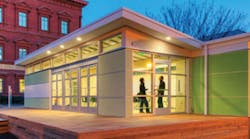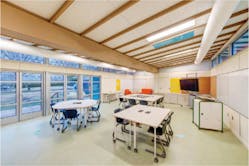The Sprout Space modular classroom, now on display at the National Building Museum in Washington, DC, may represent the classroom of the future: a flexible, comfortable, net-zero-energy learning environment.
Architectural firm Perkins+Will enlisted the aid of HVAC system designer John Michael, owner, Modular Air, Mt. Dora, FL, to help achieve the vision of a net-zero modular classroom.
“The design intent was to put the pieces in place from a mechanical perspective that would make us zero-energy to the grid,” Michael told Contracting Business. “The recipe for that is pretty simple: you need an inverter-style heat pump, energy recovery, a demand-controlled ventilation strategy, and you need to provide solar energy at just enough kW that you don’t over-do or under-do it.”
Michael’s design incorporates an LG Multi-V Mini variable-refrigerant-flow unit for HVAC, an LG Mono X Module for solar, ACI carbon-dioxide sensors, an AirXchange energy-recovery ventilator, and fabric ductwork from KE Fibertec North America, Inc.
The classroom’s solar modules are a unique element of the project. Michael knew that a solar solution was necessary to get the modular unit to net-zero efficiency, but also knew the solar component had to be flexible enough that a unit could be put together quickly. His solution was a proprietary solar panel system for modular buildings including a factory installed racking system, properly installed and grounded invertors, and 16 LG Mono X solar modules equated to a 4 KW power plant. This system was developed and designed by Modular Air and is marketed as the Greenergy 1000. This unique setup allowed the unit to be shipped with solar already installed, a first for the industry.
“The solar system on the roof is marketed under my company’s label,” Michael explains. “The LG panels are prefabricated by being bonded to racking, and the building ships to site with the solar attached. All the installer has to do is connect the weather-proof plug between each Greenegy power pack, making the solar truly plug-and-play. When the two halves of the classroom are put together on site and everything’s connected, the solar system automatically boots up and begins producing power.”
The aggressive sizing of the solar installation is projected to provide more than 90% of the annual power required by the classroom.
“Sprout Space has a lot of neat features architecturally, but it’s not just a pretty Frank Lloyd Wright copy,” Michael adds. “It’s a wonderful, zero-energy modular classroom that was designed and executed in a factory-built environment.”
Sprout Space will serve as a prototype for a larger initiative to create a net-positive-energy modular classroom. It will remain on display at the National Building Museum until January 5, 2014.











